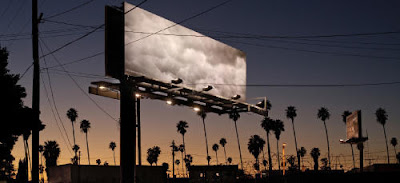Over the past couple of months, West Hollywood's MAK Center for Art and Architecture at the Shindler House has been celebrating billboards all over Los Angeles in one special way: Handing the space over to artists and letting them create the message. The art center says of this unusual experiment, "The sudden existence of artistic speech mixed in with commercial speech provides a refreshing change of pace." It distinguishes billboards as a product of the country's "aggregate of dynamic histories," of combined pop culture and commercialism, and says its billboards provoke one "to look and think."
This exhibition, "How Many Billboards? Art in Stead," remains with only a few of its original 20 still on view throughout the Beverly Hills and Culver City area; and a show book is scheduled to debut in June.
As a relative to ubiquitous Los Angeles palm tree, billboards are more equal counterparts to neon signs for its role and commercial purpose in the vast urban landscape. If you love the bright lights of neon, then "How Many Billboards? Art in Stead" is something to explore. Below, a brief list of billboards that remain from this exhibition.

Artist-scholar Ken Gonzales-Day's board sits on Olympic Blvd. west of Gramercy Pl. (close to Wilshire Center) and reminds how much of present-day visuals come from the past. [Photo Source: MAK Center]

Artist Kerry Tribe's billboard makes us dream-bound on La Brea Ave., north of Venice Blvd. [Photo Source: MAK Center]























